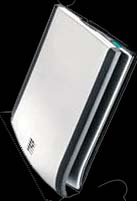Hardware
Audio
Controllers
General
Mainboards
Modems
Monitors
Portables
Printers
Processors
Scanners
Storage
Video
Games
Reviews
Previews
Cheats
& Hints
News
General Info
About
Us
Advertising
Awards
Contact
Us
Hot
Links
|
Overview Look at the Palm V PDAs and your first impression
will probably be ďItís tiny!Ē The anodized aluminum case is only half as
thick as a Palm III, slim and PDAs subtly curved. Itís seductively eye-catching:
if people bought PDAs simply on the basis of how good they look, this would
probably break all records. However, people donít, or at least, shouldnít
and those of us who are tempted must harden our hearts and abstain from
such sinful abandon. Anyhow; PDAs the Palm V definitely gives out some
positive vibes. Pick it up- itís light,PDAs but only slightly lighter than
a Palm III, thanks to the formerís metal case. It feels solid and it is:
you canít take it apart. In other words, it isnít upgradable. Unlike previous
Palm models,PDA you wonít be able to add more memory to the Palm V. Just
hope that the 2MB it comes with is enough- but more on that later PDA.
The leather PDA cover is fairly rigid, and is hinged so that you can flip it all the way back behind the unit, though it wonít sit flat on the PDA back. (It wonít sit quite flat on the front either, unless you twist it a little forward when youíre inserting the spine into the groove.) The PDA leather flap doesnít offer much in the way of protection, and for those for PDA whom this is an issue can opt for the $39 clam-shell aluminum case. More elaborate cases are also available from various PDA third-party vendors. The top of the unit has the On/Off power button on the PDA right corner, which also toggles the backlight on and off by holding it down for a few more seconds. Also on top are the IR port and contrast control button. Yep,PDA that means weíve finally seen the end of the contrast wheel, all hail, all hail. When the unit is switched on, press the contrast PDA control button to get a slider control onscreen. The location of the power PDA button is a little annoying if you opt to keep your stylus in the right-hand groove and the flap cover is attached to the left-hand PDA groove- which is, if youíre right-handed, a natural way to arrange PDA matters. I say itís annoying because there is a tendency to keep pressing the power button by mistake when trying to remove PDA the recalcitrant stylus from the right hand groove. To fix this, youíre then PDA forced to reverse the order- put your stylus in the left-hand groove and attach the flap cover to the right-hand groove. This PDA way, the only thing you might press by PDA mistake is the contrast control button, but this has no effect when the unit is switched off. Itís initially a bit PDA jarring but it doesnít take long to get used to it. The PDA problem may not arise if youíre left-handed, in which case PDA you may have naturally attached the stylus and the cover this way. All this is really only a minor annoyance, but we all know how minor annoyances sometimes become dangerous psychoses over time, PDA especially with something thatís used as often as a PDA. |
|
|
